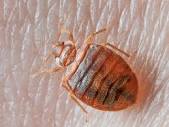Bed Bugs
Information
The Baltimore City Health Department does not have any bed bug mitigation programs; however, we are providing informational materials on bedbugs as a resource for the public.
Overview

What Are Bedbugs?
Bed bugs are small insects that feed on human blood. They can reach about 1/4 inch in length and have flat, oval-shaped, wingless bodies. They are reddish-brown in color and may be mistaken for ticks or small cockroaches.
How Does a Home Become Infested with Bed Bugs?
Bed bugs ‘hitchhike’ and people often unknowingly carry bed bugs into homes in infested luggage and bags, furniture, mattresses and box springs, bedding, or clothing. They can also travel between houses and apartments through cracks and openings in or around doors, windows, walls, and floors.
How Do I Know if My Home is Infested with Bed Bugs?
Bites are often one of the first signs of a bed bug problem. Most bed bug bites are painless at first but later become large, itchy skin welts. These welts do not have a red spot in the center like flea bites. Although bed bugs are a nuisance, they are not known to spread disease.
The bites can be very similar to other insect bites, and bed bug infestations cannot be confirmed by bites alone. You may also see the bed bugs themselves, small bloodstains from crushed insects, or dark spots from their droppings, especially on sheets or other bedding.
How Can I Get Rid of Bed Bugs?
For residents who can afford to do so, the Baltimore City Health Department recommends hiring licensed pest management professionals for bed bug eradication. At a minimum, the pest control company should:
- Inspect your home to confirm the presence of bed bugs.
- Find and remove bed bugs and eliminate hiding places.
- Make at least one return visit to make sure bed bugs are gone.
Be sure to hire and work with a licensed professional. Bed bug treatment will involve extensive preparation and follow-up on the part of residents that may require a ‘working relationship’ with a professional. Ask to see a copy of the license or check directly with the Maryland Department of Agriculture by calling 410-841-5710 or visiting the MDA's Website.
Pest control professionals may use a pesticide. Talk with the professional about the safe use of pesticides and make sure they:
- Use the least toxic pesticide.
- Follow instructions and warnings on product labels.
- Advise you to stay out of treated rooms and when it is safe to return.
In all cases, please note that many conventional, over-the-counter pest control products, such as foggers and bug bombs, are ineffective and could make a bed bug problem worse.
Additional Information:
- Find out where bed bugs are hiding in your home. Starting on or around a bed, use a flashlight to look for bed bugs and signs such as shed skins or stains from droppings. Check:
- Behind your headboard and in joints of bed frames.
- The seams of your mattress and inside the box spring.
- Along bedroom baseboards.
- In and around nightstands and other furniture.
- Other bedroom items and locations where bed bugs could hide, such as windows and door casings, pictures, moldings, cracks in plaster and partitions, in or around electrical outlets and venting, and clutter.
- In general, any space the width of a credit card can be a hiding place for bed bugs.
- Clean and de-clutter areas where bed bugs are likely to hide and remove bed bugs.
- Clean up the clutter. A cluttered home provides more places for bed bugs to hide and makes locating and treating them more difficult.
- Heat kills bed bugs and their eggs. Clean bedding, linens, curtains, rugs, carpets, and clothes. Wash items in hot water and dry them on the highest dryer setting for 60 minutes. Such items also can be placed dry in a dryer on the highest setting for half an hour. Soak delicate clothes in warm water with lots of laundry soap for several hours before rinsing.
- Carefully scrub mattress seams with a stiff brush to dislodge bed bugs and eggs.
- Vacuum mattresses, bed frames, furniture, floors, and carpets. Pay special attention to cracks and open spaces. Immediately after vacuuming, put the vacuum bag in a sealed plastic bag and dispose of it in an outdoor container.
- If you find bed bugs on a mattress, cover it with a zippered mattress cover labeled for bed bugs. Pay special attention to the zipper enclosure to ensure a tight seal. Keep the cover on for at least one year.
- If your box spring is infested, also seal it inside an encasement for at least one year. If no cover is available, seal the mattress in 6 mil plastic and duct tape and label "Bed Bugs" and throw it away.
- Bed bug interceptors can be very effective for trapping bedbugs moving to and from beds and other furniture.
- Dispose of infested items or clutter that can't be cleaned. Seal tightly in a plastic garbage bag and discard in an outside container.
- Repair cracks in plaster and lose wallpaper and seal or eliminate other potential hiding places.
- Be very cautious about using pesticides yourself. Pesticides can be hazardous to people and pets. Pesticides alone are rarely effective for bed bug eradication and are not advised. If you choose to use a pesticide, follow these precautions:
- Only use pesticides clearly labeled for bed bugs. Never use a cockroach spray or other pesticide that does not list bed bugs on the label.
- Follow label instructions exactly.
- Understand that use may build resistance to the pesticide within the infestation.
- Never spray pesticides on top of a mattress or sofas, or in areas where children are present.
- Avoid "insecticide bombs" and "foggers" in your home. These products can spread hazardous chemicals throughout your home and often drive bed bugs into ‘deeper’ hiding places.
- Safer products such as food-grade diatomaceous earth are no less effective for control than any other residual pesticide.
How Can I Keep Bed Bugs Out of My Home?
- Wash clothing and bedding immediately after returning from a trip.
- Inspect used furniture for bed bugs before bringing it into your home.
- Never bring discarded bed frames, mattresses, box springs, or upholstered furniture into your home.
How Can I Keep from Spreading an Infestation?
- Never resell or donate infested furniture.
- Infested furniture and other items should be marked, destroyed, or made unusable to the extent possible.
Educational Materials
- Este manual proporciona instrucciones paso a paso sobre cómo usted puede identificar, prevenir y eliminar a las chinches (pdf).
- Battling Bed Bugs Safely: A Guide to Preventing and Eliminating Bed Bugs (2011)
- What to Do About Stink Bugs and Bed Bugs (MPT Video)
- Bed Bugs: What they are and How to Avoid, Detect and Treat (pdf)
Related Links
More Information

